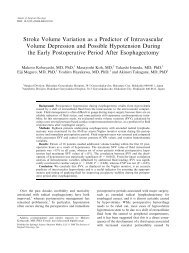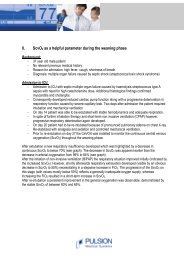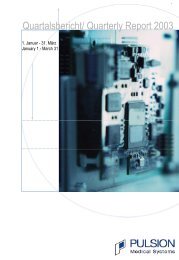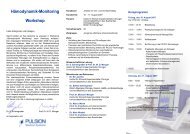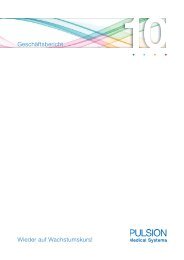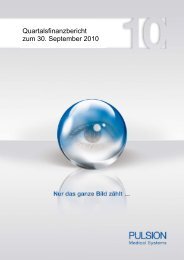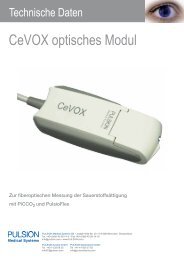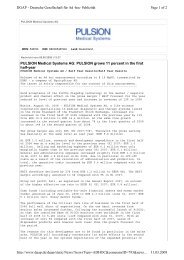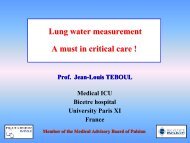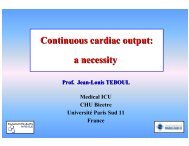View - PULSION Medical Systems SE
View - PULSION Medical Systems SE
View - PULSION Medical Systems SE
You also want an ePaper? Increase the reach of your titles
YUMPU automatically turns print PDFs into web optimized ePapers that Google loves.
Intensive Care Med<br />
DOI 10.1007/s00134-007-0669-0<br />
Jan Kozieras<br />
Oliver Thuemer<br />
Samir G. Sakka<br />
Received: 17 November 2006<br />
Accepted: 19 April 2007<br />
© Springer-Verlag 2007<br />
This work was presented in part at the 19th<br />
annual meeting of the European Society of<br />
Intensive Care Medicine, 24–27 September<br />
2006, Barcelona.<br />
Samir Sakka has received fees from Pulsion<br />
<strong>Medical</strong> <strong>Systems</strong> AG, Munich, Germany,<br />
for giving lectures.<br />
J. Kozieras · O. Thuemer<br />
Friedrich-Schiller-University of Jena,<br />
Department of Anesthesiology and Intensive<br />
Care Medicine,<br />
Jena, Germany<br />
S. G. Sakka (✉)<br />
<strong>Medical</strong> Center Cologne-Merheim,<br />
Department of Anesthesiology and Intensive<br />
Care Medicine,<br />
Ostmerheimerstrasse 200, 51109 Cologne,<br />
Germany<br />
e-mail: sakkas@kliniken-koeln.de<br />
Tel.: +49-221-89073863<br />
Fax: +49-221-89073868<br />
Abstract Objective: The transpulmonary<br />
thermodilution technique<br />
Introduction<br />
BRIEF REPORT<br />
Transpulmonary indicator dilution techniques are increasingly<br />
being used in the intensive care unit for<br />
Influence of an acute increase in systemic<br />
vascular resistance on transpulmonary<br />
thermodilution-derived parameters<br />
in critically ill patients<br />
enables measurement of cardiac<br />
index (CI), intrathoracic blood volume<br />
(ITBV), global end-diastolic<br />
volume (GEDV), and extravascular<br />
lung water (EVLW). In this study,<br />
we analyzed the robustness of this<br />
technique during an acute increase in<br />
systemic vascular resistance (SVR).<br />
Design: Prospective, clinical study.<br />
Setting: Surgical intensive care unit<br />
in a university hospital. Patients and<br />
methods: Twenty-four mechanically<br />
ventilated septic shock patients, who<br />
for clinical indications underwent<br />
extended hemodynamic monitoring<br />
by transpulmonary thermodilution<br />
and continuously received norepinephrine.<br />
Interventions and main<br />
results: After baseline measurements,<br />
mean arterial pressure was increased<br />
briefly by increasing norepinephrine<br />
dosage and hemodynamic measurements<br />
were repeated before a control<br />
measurement was obtained. At each<br />
time point, 15 cc of 0.9% saline<br />
(< 8 °C) was administered by central<br />
venous injection in triplicate. Fluid<br />
status and respirator adjustments<br />
were kept constant. ANOVA with an<br />
all-pairwise comparison method was<br />
used for statistical analysis. Heart<br />
rate, central venous pressure, and<br />
EVLW remained constant throughout,<br />
while SVR significantly<br />
changed from 551 ± 106 to<br />
746 ± 91 dyn*s*cm –5 and again<br />
to 566 ± 138 dyn*s*cm –5 (p < 0.05).<br />
However, CI and central blood<br />
volumes showed a reversible significant<br />
increase, i.e., ITBV went from<br />
816 ± 203 to 867 ± 195 ml/m 2 and<br />
then to 821 ± 205 ml/m 2 and GEDV<br />
from 703 ± 178 to 747 ± 175 ml/m 2<br />
and finally to 704 ± 170 ml/m 2 ,<br />
respectively. In eight patients, 2-D<br />
echocardiography was applied and<br />
revealed a reversible increase in<br />
left-ventricular end-diastolic area.<br />
Conclusion: An acute increase in<br />
SVR by increasing norepinephrine<br />
dosage results in a reversible increase<br />
in central blood volumes (ITBV,<br />
GEDV) as measured by transpulmonary<br />
thermodilution and supported<br />
by echocardiography.<br />
Keywords Hemodynamic monitoring<br />
· Transpulmonary thermodilution<br />
technique · Critically ill patients<br />
hemodynamic monitoring. The transpulmonary thermodilution<br />
technique allows assessment of cardiac output<br />
and cardiac function, central blood volumes and capillary<br />
leakage. In detail, cardiac index (CI), global ejection
fraction (GEF), intrathoracic blood volume (ITBV), global<br />
end-diastolic volume (GEDV), and extravascular lung<br />
water (EVLW) may be determined.<br />
In particular, the single transpulmonary thermodilution<br />
technique has been found to be accurate for assessment<br />
of ITBV and EVLW compared with the double-indicator<br />
technique, which is regarded as the clinical reference technique<br />
[1, 2]. In general, ITBV is superior to the cardiac<br />
filling pressures for estimating cardiac preload in critically<br />
ill patients [3–6]. Furthermore, guidance of treatment by<br />
the transpulmonary indicator technique has the potential to<br />
reduce the duration of mechanical ventilation, ICU length<br />
of stay and mortality [7, 8].<br />
However, single transpulmonary thermodilution,<br />
which has been deduced from the double-indicator<br />
technique, may be prone to various problems that may<br />
occur in the clinical situation. To date, the correctness of<br />
transpulmonary thermodilution-derived ITBV and EVLW<br />
values has been confirmed during changes in cardiac<br />
output, i.e. by β-mimetic or β-blocking agents. However,<br />
acute changes in cardiac afterload, which frequently occur<br />
in critically ill patients, may also influence the accuracy of<br />
this technique. We therefore tested whether acute changes<br />
in systemic vascular resistance influences transpulmonary<br />
thermodilution-derived variables in critically ill patients<br />
requiring vasopressor support.<br />
throughout the study period. Inspiratory oxygen fraction<br />
(40 ± 10%), minute volume and airway pressures (i.e.,<br />
PEEP 10 ± 5 mbar) remained constant. Fluid status and<br />
infusion rates of other vasoactive or sedative drugs were<br />
unchanged. In eight patients, transesophageal echocardiography<br />
(TEE) (Sonos 2500, probe HP 5.0/3.7 MHz, model<br />
21364A, Hewlett Packard, CA, USA) was performed,<br />
allowing a transgastric two-dimensional short-axis<br />
view for measurement of left-ventricular end-systolic<br />
and end-diastolic areas at the mid-papillary muscle<br />
level. Echocardiography was chosen as reference, since<br />
a correlation between changes in ITBV as determined<br />
by transpulmonary thermo-dye dilution technique and<br />
left-ventricular end-diastolic area (LVEDA) has been described<br />
[9, 10]. In these eight patients, also pulse contour<br />
cardiac output (PCCO) was recorded before each bolus<br />
measurement.<br />
Statistical analysis<br />
All data are given as mean ± standard deviation (SD). Results<br />
were compared by an ANOVA on ranks for repeated<br />
measures (Friedman test) and a post-hoc all-pairwise<br />
comparison procedure (Student–Keuls method). Furthermore,<br />
linear regression analysis was used for comparison<br />
between changes in GEDV/ITBV and changes in LVEDA.<br />
Statistical significance was considered at p < 0.05. For<br />
the statistical analysis, we used SigmaStat ® for Windows<br />
(version 1.0).<br />
Patients and methods<br />
After approval from our local ethics committee and<br />
informed consent (from next-of-kin), we enrolled 24<br />
mechanically ventilated septic shock patients (16 male,<br />
8 female, age 26–71 years). All patients continuously<br />
received norepinephrine for hemodynamic support and<br />
underwent monitoring by the transpulmonary thermodilution<br />
technique (PiCCOplus ® , version 7.0 non US,<br />
Pulsion <strong>Medical</strong> <strong>Systems</strong>, Munich, Germany) for clinical<br />
indications. Patients had a femoral arterial 5-F thermistor<br />
catheter (PV20L15, Pulsion <strong>Medical</strong> <strong>Systems</strong>)<br />
and a central venous catheter (Certofix trio ® Results<br />
, Braun<br />
The patients’ average weight was 83 ± 20 kg (range<br />
56–150), height 171 ± 12 cm (range 158–204) and body<br />
surface area 2.0 ± 0.3 m<br />
Melsungen, Germany) in situ. For each measurement of<br />
CI, intrathoracic blood volume index (ITBVI), global<br />
end-diastolic volume index (GEDVI), and extravascular<br />
lung water index (EVLWI), 15 cc 0.9% saline (< 8°C)<br />
was administered by central venous injection in triplicate.<br />
Baseline values were obtained before raising mean<br />
arterial pressure (MAP) to about 90 mmHg by increasing<br />
continuous rate of norepinephrine infusion for 5 min. The<br />
second measurement was obtained during steady state at<br />
the higher MAP level. Then norepinephrine dosage was<br />
reduced to baseline conditions and a control measurement<br />
was obtained 5 min later.<br />
All patients were sedated and ventilated in a pressurecontrolled<br />
mode (BiPAP, Evita 4, Dräger, Lübeck,<br />
Germany). Respirator adjustments remained unchanged<br />
2 (range 1.6–2.9). Study patients<br />
were characterized by a mean APACHE II score of 26 ± 8<br />
(range 7–43) and SAPS II score of 51 ± 15 (range 17–73).<br />
While mean norepinephrine dosage was changed<br />
from 0.05 ± 0.04 (range 0.01–0.15) to 0.11 ± 0.09<br />
(range 0.01–0.40) and finally back to 0.05 ± 0.05 (range<br />
0.01–0.15) µg/kg/min, MAP changed from 66 ± 9 to<br />
92 ± 9 and back to 68 ± 12 mmHg. Accordingly, systemic<br />
vascular resistance (SVR) was 551 ± 106, 746 ± 91,<br />
and 566 ± 138 dyn*s*cm –5 . In parallel, systolic blood<br />
pressure increased to 139 ± 13 (median 140) mmHg.<br />
Heart rate, central venous pressure, GEF and EVLWI did<br />
not change significantly. Stroke volume variation (SVV)<br />
also did not change significantly (10 ± 6, 10 ± 6, and<br />
11 ± 6%).<br />
However, ITBVI and GEDVI significantly increased<br />
during the intervention (Table 1). Overall stability of<br />
measurements was confirmed, as the coefficients of variation<br />
(SD/mean) for cardiac output, ITBVI and EVLWI<br />
at the three time points were: 4.7 ± 2.6, 6.3 ± 3.7, and
Table 1 Hemodynamic parameters<br />
Parameter Baseline Intervention Control<br />
HR (1/min) 98 ± 19 (100) 95 ± 17 (94) 94 ± 19 (95)<br />
CVP (mmHg) 12 ± 5 (12) 13 ± 7 (13) 12 ± 5 (13)<br />
CI (l/min/m 2 ) 3.3± 0.9 (3.4) 3.4 ± 0.9 (3.6) ∗ 3.3 ± 0.9 (3.3)<br />
SVR (dyn ∗ s ∗ cm −5 ) 551 ± 106 (535) 746 ± 91 (759) ∗ 566 ± 138 (525)<br />
GEF (%) 22 ± 6 (22) 22 ± 6 (23) 23 ± 7 (22)<br />
GEDVI (ml/m 2 ) 703 ± 178 (705) 747 ± 175 (761) ∗ 704 ± 170 (696)<br />
ITBVI (ml/m 2 ) 816 ± 203 (827) 867 ± 195 (915) ∗ 821 ± 205 (853)<br />
EVLWI (ml/kg) 7.0 ± 2.7 (7.0) 7.5 ± 3.0 (7.0) 7.4 ± 3.0 (7.0)<br />
Values are mean ± standard deviation (median).<br />
HR, Heart rate; CVP, central venous pressure; CI, cardiac index; SVR, systemic vascular resistance; GEF, global ejection fraction; GEDVI,<br />
global end-diastolic volume index; ITBVI, intrathoracic blood volume index; EVLWI, extravascular lung water index.<br />
∗ p < 0.05, ANOVA on ranks with a post-hoc all-pairwise comparison procedure (Student–Keuls)<br />
Fig. 1 a Linear regression<br />
analysis between changes in left<br />
ventricular end-diastolic area<br />
(LVEDA) and changes in global<br />
end-diastolic volume (GEDV).<br />
Line of regression is bold; 95%<br />
confidence intervals are<br />
indicated by the dashed lines.<br />
r =0.59(p = 0.02). b Linear<br />
regression analysis between<br />
changes in left-ventricular<br />
end-diastolic area (LVEDA)and<br />
changes in intrathoracic blood<br />
volume (ITBV). Line of<br />
regression is bold; 95%<br />
confidence intervals are<br />
indicated by the dashed lines.<br />
r =0.66(p = 0.005)<br />
4.9 ± 2.7%; 5.0 ± 2.5, 6.2 ± 4.0, and 4.9 ± 2.6 %; and<br />
5.6 ± 3.9, 6.0 ± 4.8, and 6.8 ± 4.0%, respectively.<br />
Transesophageal echocardiography (n = 8) revealed<br />
that LVEDA index changed from 10.4 ± 4.7 to<br />
12.4 ± 3.8 cm 2 /m 2 and finally to 9.7 ± 3.3 cm 2 /m 2<br />
(p < 0.05). In these patients, left-ventricular fractional<br />
area change (LV-FAC) was unchanged, i.e., it went from<br />
37 ± 12% to 36 ± 12% and 38 ± 11%. Both changes<br />
in GEDV and changes in ITBV were correlated with<br />
changes in LVEDA (Fig. 1). In these eight patients,<br />
PCCO also reversibly increased (6.4 ± 1.9, 7.3 ± 2.3, and<br />
6.2 ± 2.1 l/min) (not significantly different between the<br />
three different time points).<br />
Discussion<br />
We found that an acute increase in SVR by increasing<br />
norepinephrine dosage results in a reversible increase in<br />
transpulmonary thermodilution technique-derived central<br />
blood volumes, i.e., ITBVI and GEDVI.<br />
Both GEDVI and ITBVI are used as indicators of<br />
cardiac preload. However, GEDVI may be obtained from<br />
single transpulmonary thermodilution and allows calculation<br />
of ITBVI, which normally requires the thermo-dye dilution<br />
technique. According to experimental and clinical<br />
studies, ITBV can be derived accurately from GEDV by<br />
using a defined algorithm [1, 2].<br />
In principle, ITBV is calculated by using cardiac<br />
output and the issue of mathematical coupling has been<br />
raised previously. However, changes in cardiac output per<br />
se do not influence measurements of ITBV [11]. While<br />
cardiac output significantly increased during dobutamine<br />
(by 31.7%), ITBV remained unchanged (mean increase<br />
2.84%) [12]. Also, β-blockade caused substantial alterations<br />
in cardiac output which were not associated with<br />
changes in ITBV. Because hemodynamic changes were<br />
induced by factors other than variation of preload, these<br />
findings suggest that changes in cardiac output do not<br />
influence thermodilution measurements of ITBV and<br />
EVLW. As demonstrated in animals [13], dobutamine<br />
infusion increased CI by 30% while ITBV remained<br />
unchanged. In summary, the CI/GEDVI measures are<br />
mathematically coupled but this does not exclude noncoupled,<br />
physiologically independent variance, and this is<br />
what our study demonstrates again.
ITBV has been found to correlate well with cardiac<br />
volumes and its changes are better correlated with changes<br />
in cardiac volumes than are the filling pressures [13, 15,<br />
16]. Hinder et al. [9] described that changes in ITBV are<br />
well correlated with changes in LVEDA. These echocardiographic<br />
findings may be interpreted as supporting<br />
thermodilution-derived measurements. Furthermore, in<br />
patients with preserved left–right ventricular function [10]<br />
GEDV was found to give a reliable reflection of echocardiographic<br />
changes in left-ventricular preload following<br />
fluid loading.<br />
With respect to assessment of myocardial contractility,<br />
GEF has been found to provide reliable estimation of leftventricular<br />
systolic function but may underestimate it in<br />
the case of isolated right ventricular failure [17]. In our<br />
study, the increase in cardiac volumes was associated with<br />
a significant increase in cardiac output, as expected from<br />
the Frank–Starling law. Thus, GEF was unchanged and this<br />
was confirmed by LV-FAC.<br />
Finally, although the difference was not statistically<br />
significant, also PCCO showed a reversible increase in CO<br />
in our study. So far, pulse contour-derived cardiac output<br />
has been shown to remain reliable during increasing SVR<br />
(using phenylephrine and reversibly increasing MAP<br />
from 68 ± 6to95± 9 mmHg) [18]. In contrast, we used<br />
norepinephrine which is not a pure α-agonist but has<br />
α- andβ-adrenergic properties, because it is the first-line<br />
vasopressor agent in our department.<br />
References<br />
1. Neumann P (1999) Extravascular<br />
lung water and intrathoracic blood<br />
volume: double versus single indicator<br />
dilution technique. Intensive Care Med<br />
25:216–219<br />
2. Sakka SG, Ruhl CC, Pfeiffer UJ,<br />
Beale R, McLuckie A, Reinhart K,<br />
Meier-Hellmann A (2000) of cardiac<br />
preload and extravascular lung water by<br />
single transpulmonary thermodilution.<br />
Intensive Care Med 26:180–187<br />
3. Lichtwarck-Aschoff M, Zeravik J,<br />
Pfeiffer UJ (1992) Intrathoracic blood<br />
volume accurately reflects circulatory<br />
volume status in critically ill patients<br />
with mechanical ventilation. Intensive<br />
Care Med 18:142–147<br />
4. Sakka SG, Bredle DL, Reinhart K,<br />
Meier-Hellmann A (1999) Comparison<br />
between intrathoracic blood volume<br />
and cardiac filling pressures in the early<br />
phase of hemodynamic instability of<br />
patients with sepsis or septic shock.<br />
J Crit Care 14:78–83<br />
Our study has several limitations. First, we did not<br />
use the transpulmonary double-indicator technique, which<br />
may be regarded as the clinical reference standard.<br />
Furthermore, one could speculate that an acute increase<br />
in SVR might produce differential effects on cardiac<br />
dimensions depending on basal cardiac function. Unfortunately,<br />
our data are too limited to allow such an analysis.<br />
Although merely two-dimensional echocardiography was<br />
used to assess left-ventricular volume and not volumes<br />
of all cardiac (i.e., right heart) chambers, we found<br />
a similar change in LVEDA and central blood volumes<br />
during increase in SVR. Probably, determination of whole<br />
cardiac blood volume by magnetic resonance imaging<br />
or radionuclide techniques would give more insight.<br />
However, we decided to use a clinical monitoring system<br />
since the above-mentioned techniques are not practicable<br />
in the routine ICU setting.<br />
Conclusion<br />
5. Godje O, Peyerl M, Seebauer T,<br />
Lamm P, Mair H, Reichart B (1998)<br />
Central venous pressure, pulmonary<br />
capillary wedge pressure and intrathoracic<br />
blood volumes as preload<br />
indicators in cardiac surgery patients.<br />
Eur J Cardiothorac Surg 13:533–539<br />
6. Hoeft A, Schorn B, Weyland A,<br />
Scholz M, Buhre W, Stepanek E,<br />
Allen SJ, Sonntag H (1994) Bedside assessment<br />
of intravascular volume status<br />
in patients undergoing coronary bypass<br />
surgery. Anesthesiology 81:76–86<br />
7. Mitchell JP, Schuller D, Calandrino FS,<br />
Schuster DP (1992) Improved outcome<br />
based on fluid management in critically<br />
ill patients requiring pulmonary artery<br />
catheterization. Am Rev Respir Dis<br />
145:990–998<br />
8. Eisenberg PR, Hansbrough JR,<br />
Anderson D, Schuster DP (1987)<br />
A prospective study of lung water measurement<br />
during patient management in<br />
an intensive care unit. Am Rev Respir<br />
Dis 136:662–668<br />
An acute increase in systemic vascular resistance by<br />
increasing norepinephrine dosage results in a reversible<br />
increase in central blood volumes (ITBV, GEDV) as measured<br />
by the transpulmonary thermodilution technique.<br />
These findings are supported insofar as two-dimensional<br />
transesophageal echocardiography revealed an increase in<br />
LVEDA.<br />
9. Hinder F, Poelaert JI, Schmidt C,<br />
Hoeft A, Mollhoff T, Loick HM,<br />
Van Aken H (1998) Assessment of<br />
cardiovascular volume status by transoesophageal<br />
echocardiography and<br />
dye dilution during cardiac surgery. Eur<br />
J Anaesthesiol 15:633–640<br />
10. Hofer CK, Furrer L, Matter-Ensner S,<br />
Maloigne M, Klaghofer R, Genoni M,<br />
Zollinger A (2005) Volumetric preload<br />
measurement by thermodilution:<br />
a comparison with transoesophageal<br />
echocardiography. Br J Anaesth<br />
94:748–755<br />
11. Buhre W, Kazmaier S, Sonntag H,<br />
Weyland A (2001) Changes in cardiac<br />
output and intrathoracic blood volume:<br />
a mathematical coupling of data? Acta<br />
Anaesthesiol Scand 45:863–867<br />
12. McLuckie A, Bihari D (2000) Investigating<br />
the relationship between<br />
intrathoracic blood volume index and<br />
cardiac index. Intensive Care Med<br />
26:1376–1378
13. Lichtwarck-Aschoff M, Beale R, Pfeiffer<br />
UJ (1996) Central venous pressure,<br />
pulmonary artery occlusion pressure,<br />
intrathoracic blood volume, and right<br />
ventricular end-diastolic volume as<br />
indicators of cardiac preload. J Crit<br />
Care 11:180–188<br />
14. Buhre W, Weyland A, Schorn B,<br />
Scholz M, Kazmaier S, Hoeft A,<br />
Sonntag H (1999) Changes in central<br />
venous pressure and pulmonary capillary<br />
wedge pressure do not indicate<br />
changes in right and left heart volume<br />
in patients undergoing coronary artery<br />
bypass surgery. Eur J Anaesthesiol<br />
16:11–17<br />
15. Sakka SG, Bredle DL, Reinhart K,<br />
Meier-Hellmann A (1999) Comparison<br />
between intrathoracic blood volume<br />
and cardiac filling pressures in the early<br />
phase of hemodynamic instability of<br />
patients with sepsis or septic shock.<br />
J Crit Care 14:78–83<br />
16. Lichtwarck-Aschoff M, Zeravik J,<br />
Pfeiffer UJ (1992) Intrathoracic blood<br />
volume accurately reflects circulatory<br />
volume status in critically ill patients<br />
with mechanical ventilation. Intensive<br />
Care Med 18:142–147<br />
17. Combes A, Berneau JB, Luyt CE,<br />
Trouillet JL (2004) Estimation of<br />
left ventricular systolic function by<br />
single transpulmonary thermodilution.<br />
Intensive Care Med 30:1377–1383<br />
18. Weissman C, Ornstein EJ, Young WL<br />
(1993) Arterial pulse contour analysis<br />
trending of cardiac output: hemodynamic<br />
manipulations during cerebral<br />
arteriovenous malformation resection.<br />
J Clin Monit 9:347–353





